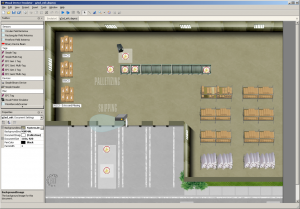Modeling real world environments and developing solutions without investing in a costly and potentially redundant hardware infrastructure is critical to today’s deployments of RFID devices, notification devices, state change devices, and sensor interfaces.
A visual device emulator provides the user with a tool that can be used to develop and maintain RFID based solutions, test solution components and scenarios before deploying them into production, demonstrate to and train users on the production solution and test new (future) processes or the introduction of new hardware components to the solution.
All of these activities are possible without impacting the production environment or requiring any hardware to be dedicated to these non-production tasks.

GlobeRanger’s Visual Device Emulator (VDE), included as part of the iMotion Platform, is a revolutionary tool for developing RFID solutions.
The VDE can simulate real-world behavior of readers, sensors, antenna fields and tags.
Developers can leverage this tool to rapidly design and optimize RFID applications and to eliminate the dependence on hardware for testing and integrating RFID systems.
The VDE is an innovative, graphical emulation environment where real-world behavior of readers, antenna fields, and tags, can be easily simulated, allowing developers to test various application components against simulated physical deployment scenarios.
Movement of tagged items can be done manually with drag-and-drop, or scripted for repeatable testing.
For example, the emulation environment enables developers to write macros to simulate continual tag-read events, generating not only RFID data, but also emulate the data volumes for performance testing and integration.
Devices that are modeled within the VDE utilize the same types of interfaces implemented by actual hardware.
For instance, the RFID reader acts as a TCP/IP device and implements a wire level protocol that is consistent with physical readers.
The device management layer of the iMotion Platform does not treat the emulated devices any differently than physical hardware thus emulated devices can be used interchangeably with physical devices.
In fact, the platform does not “know” that some devices are emulated and others are ‘real’.
This also means that all other parts of the solution can be developed, configured, and tested independently from the physical hardware by using emulated hardware.
Those parts of the solution do not change when the underlying hardware (emulated or physical) is changed.
There is not a standard protocol, nor a standard communications model for RFID hardware (though there are standards initiatives underway at EPCglobal and other groups, which will be supported by iMotion once available).
The emulated reader in the VDE implements a superset of common communications models which covers all of the common mechanisms which are employed by today’s reader hardware so that each of these models can be employed where appropriate.
The VDE is highly configurable, customizable, and extensible.
Configuration parameters are available for each of the provided components.
For example, a simulated RFID reader can be assigned an Alpha Error which simulates interference or other environmental issues that may affect tag reads so that a solution can be tested against real-world conditions.
The user can easily change the graphical representation of items within the emulator environment to appear more consistent with the physical environment.
Also, the VDE has a complete SDK which enables the creation of custom objects.
For instance, an end user may wish to create a forklift object with an integrated reader and antenna field to create a mobile reader.
All standard objects supplied with the VDE have been built using the same SDK that is available to the user.
GlobeRanger’s Visual Device Emulator is the premier emulation tool in the RFID industry.


